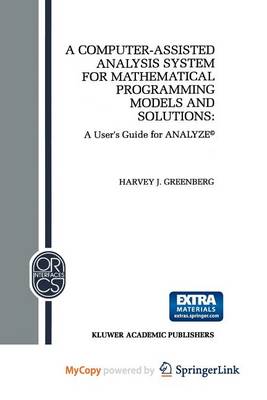Operations Research/Computer Science Interfaces
2 primary works
Book 1
A Computer-Assisted Analysis System for Mathematical Programming Models and Solutions
by H J Greenberg
Published 31 March 1993
Welcome to ANALYZE, designed to provide computer assistance for analyzing linear programs and their solutions. Chapter 1 gives an overview of ANALYZE and how to install it. It also describes how to get started and how to obtain further documentation and help on-line. Chapter 2 reviews the forms of linear programming models and describes the syntax of a model. One of the routine, but important, functions of ANALYZE is to enable convenient access to rows and columns in the matrix by conditional delineation. Chapter 3 illustrates simple queries, like DISPLAY, LIST, and PICTURE. This chapter also introduces the SUBMAT command level to define any submatrix by an arbitrary sequence of additions, deletions and reversals. Syntactic explanations and a schema view are also illustrated. Chapter 4 goes through some elementary exercises to demonstrate computer assisted analysis and introduce additional conventions of the ANALYZE language. Besides simple queries, it demonstrates the INTERPRT command, which automates the analysis process and gives English explanations of results. The last 2 exercises are diagnoses of elementary infeasible instances of a particular model. Chapter 5 progresses to some advanced uses of ANALYZE. The first is blocking to obtain macro views of the model and for finding embedded substructures, like a netform. The second is showing rates of substitution described by the basic equations. Then, the use of the REDUCE and BASIS commands are illustrated for a variety of applications, including solution analysis, infeasibility diagnosis, and redundancy detection.
Book 2
Modeling by Object-Driven Linear Elemental Relations (MODLER) is a computer language for representing linear programming models, completely separate from instances defined by data realizations. It also includes representations of binary variables and logical constraints, which arise naturally in large-scale planning and operational decision support. The basic input to MODLER is a model file, and its basic output is a matrix file that is in a standard (MPS) format for most optimizers and for ANALYZE and RANDMOD. MODLER can also generate a syntax file for ANALYZE to enable automatic translation of activities and constraints into English for intelligent analysis support. The book is accompanied by a DOS version of MODLER on 3.5 inch diskettes and A Laboratory Manual for Teaching Linear Programming is available upon request.

